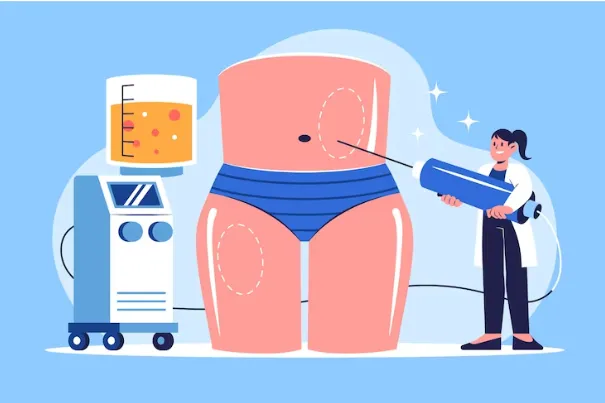Abdominoplasty, commonly known as a tummy tuck, is a transformative cosmetic surgery aimed at enhancing abdominal contouring. This procedure targets excess skin and fat, tightening abdominal muscles to achieve a flatter, more toned appearance. With its focus on aesthetic refinement, abdominoplasty remains a popular choice for those seeking to sculpt their midsection.
Types of Skin Lift: Arm Lift and Thigh Lift
Abdominoplasty, commonly known as a tummy tuck, is a surgical procedure designed to enhance the appearance of the abdomen by removing excess skin and fat while tightening the underlying muscles. It is a popular cosmetic surgery option for individuals seeking a more toned and contoured abdominal region.
The Tummy tuck, or abdominoplasty, is a surgical procedure that aims to reshape and contour the abdomen by removing excess skin and fat. It is a popular cosmetic surgery option for individuals who struggle with loose abdominal skin, stretched muscles, and stubborn fat deposits resistant to diet and exercise. Abdominoplasty surgery can provide a flatter, firmer, and more toned abdomen, restoring confidence and improving body proportion.
Abdominoplasty can address various concerns, such as loose or sagging skin, stretch marks, and weakened abdominal muscles, which may arise due to pregnancy, significant weight loss, or the natural aging process.
Aside from abdominoplasty surgery, other types of skin lift procedures can help improve the overall appearance of your body. Two standard procedures are the arm lift and thigh lift.
Clinic contact number: +989371200167
Arm Lift (Brachioplasty)
An arm lift, or brachioplasty, targets loose and sagging skin on the upper arms. It involves the removal of excess skin and fat to create a more defined and youthful arm contour. This procedure can be particularly beneficial for individuals who have experienced significant weight loss or have excess skin due to genetics or aging.
Traditional Brachioplasty
This is the standard arm lift procedure where excess skin and fat are removed from the upper arm area through an incision typically made along the inner arm, extending from the armpit to the elbow. This technique is effective for patients with moderate to severe excess skin and fat.
Mini Brachioplasty
Also known as a short scar arm lift, this procedure involves a smaller incision typically located in the armpit area. It is suitable for patients with mild to moderate excess skin and fat in the upper arms.
Extended Brachioplasty
In cases where excess skin extends beyond the upper arm to the side of the chest or towards the back, an extended brachioplasty may be performed. This involves a longer incision that extends along the arm and may continue into the chest or back area, allowing for more comprehensive skin removal and contouring.
Thigh Lift
A thigh lift focuses on reshaping and tightening the skin on the thighs. It addresses loose or sagging skin caused by weight loss, aging, or genetics. The procedure involves removing excess skin and fat to achieve a more toned and proportionate appearance in the thigh area.
Mini Abdominoplasty
A mini abdominoplasty may be recommended when the excess skin and fat are limited to the lower abdomen. This procedure involves a smaller incision and is best suited for individuals who require less extensive correction. Mini abdominoplasty targets the lower abdomen, and the recovery period is typically shorter than a full abdominoplasty.
Recovery from Abdominoplasty
Recovery from abdominoplasty surgery requires proper care and patience to ensure optimal healing and results. After the surgery, the surgeon will give the patient specific post-operative instructions. These instructions may include wearing compression garments, taking prescribed medications, and avoiding strenuous activities for a certain period. Following the surgeon’s guidelines closely promotes a smooth recovery process.
Analyzing the Surge in Demand and Procedural Innovations
Abdominoplasty, commonly known as a tummy tuck, is a surgical procedure that has seen significant advancements and research contributions from leading institutions and figures in the medical field. Prominent universities such as Johns Hopkins University and Harvard Medical School have been at the forefront of research and development in cosmetic and reconstructive surgery, including abdominoplasty.
Esteemed surgeons like Dr. Sherrell J. Aston and Dr. Rod J. Rohrich have made considerable contributions to the technique and safety of abdominoplasty, publishing numerous papers on the subject and improving procedural outcomes. Their work has focused on enhancing patient safety, optimizing aesthetic results, and minimizing recovery time, which has significantly influenced the standards of practice in the field.
The most active entity in the realm of abdominoplasty is arguably the American Society of Plastic Surgeons (ASPS), which not only tracks the statistics and trends within the field but also sets guidelines and ethical standards for its practice. According to recent ASPS reports, there were over 130,000 abdominoplasty procedures performed in the United States alone in the last year, indicating a steady increase in demand for this surgery.
This growth is attributed to the advancements in surgical techniques, including endoscopic and minimally invasive approaches, which have improved the safety profile and reduced recovery times. Furthermore, specialized terms like “lipoadominoplasty,” which combines liposuction with abdominoplasty for enhanced contouring, and “high lateral tension tummy tuck,” which addresses both vertical and horizontal skin excess, reflect the procedural innovations that continue to evolve in response to patient needs and expectations.
Clinic contact number: +989371200167
Panniculectomy vs. Abdominoplasty
Although similar, panniculectomy and abdominoplasty are distinct procedures with different goals.
Panniculectomy
Panniculectomy is a surgical procedure primarily focused on removing excess skin and fat from the lower abdomen. It is typically performed on individuals with a significant overhanging apron of skin, known as a pannus, which can cause hygiene issues and discomfort. Panniculectomy aims to alleviate these concerns and improve the patient’s quality of life.
Abdominoplasty
Abdominoplasty surgery, as mentioned earlier, involves the removal of excess skin and fat from the abdominal region, along with tightening the underlying muscles. It is a comprehensive procedure that addresses excess skin and enhances the overall contour and shape of the abdomen. Abdominoplasty surgery is commonly chosen by individuals seeking functional and aesthetic improvements in their abdominal area.

Risks of Abdominoplasty
Like any surgical procedure, abdominoplasty surgery carries certain risks. These risks may include:
- Bleeding and hematoma formation
- Infection
- Poor wound healing
- Scarring
- Changes in skin sensation
- Fluid accumulation (seroma)
- Blood clots
- Anesthesia-related complications
Discussing these risks of abdominoplasty with a qualified plastic surgeon before the procedure ensures informed decision-making and minimizes potential complications.
According to the Cleveland Clinic website:
A tummy tuck is suitable for both men and women who are in good general health overall and are at a stable weight. It’s best to be a non-smoker.
Abdominoplasty After Weight Loss
After significant weight loss, either through lifestyle changes or bariatric surgery, the excess skin in the abdominal area can often remain. this surgery can help address this issue by removing the loose skin and providing a smoother, more contoured appearance. It is essential to note that individuals considering abdominoplasty surgery after weight loss should stabilize their weight before undergoing the procedure to achieve the best results.

Abdominoplasty after pregnancy
Abdominoplasty after pregnancy can be considered to address changes in the abdominal area. Here are some critical points regarding abdominoplasty after pregnancy:
- Wait Until You Have Finished Childbearing
- Addressing Diastasis Recti
- Removing Excess Skin and Stretch Marks
Abdominoplasty Diet
Maintaining a healthy diet before and after surgery is crucial for the body’s healing process. A balanced diet rich in nutrients can promote optimal wound healing and recovery. Surgeons may provide specific dietary guidelines, including increased protein intake to aid in tissue repair, an adequate intake of fruits and vegetables for vitamins and minerals, and sufficient hydration to support overall healing.
Abdominoplasty Aftercare
Proper aftercare following abdominoplasty surgery plays a vital role in achieving the desired outcomes. After the surgery, the surgeon will provide detailed instructions regarding wound care, activity restrictions, and follow-up appointments. Attending all scheduled post-operative visits is crucial to ensure proper healing and promptly address concerns.
Abdominoplasty surgery aftercare involves the following key steps:
- Follow post-operative instructions from your surgeon.
- Wear compression garments as recommended.
- Manage pain with prescribed medications.
- Maintain good hygiene to prevent infection.
- Avoid strenuous activities initially.
- Attend follow-up appointments with your surgeon.
- Adopt a healthy lifestyle with proper nutrition and hydration.
- Follow scar care instructions provided by your surgeon.
Exercise After Abdominoplasty
Physical activity is essential to a healthy lifestyle but should be cautiously approached after abdominoplasty surgery. Initially, patients are advised to avoid strenuous exercises and activities that strain the abdominal area excessively. As the healing progresses, the surgeon will guide gradually reintroduce exercise into the routine. Following the surgeon’s recommendations is essential to avoid complications and promote optimal healing.

Abdominoplasty Aftercare
Aftercare is crucial to ensure proper healing and achieve the desired results. Patients should adhere to the surgeon’s instructions regarding wound care, wearing compression garments, and attending follow-up appointments. It is essential to promptly communicate any concerns or complications to the surgeon to receive appropriate medical attention.
Cost of Abdominoplasty
The cost of abdominoplasty surgery varies depending on various factors, including the surgeon’s expertise, geographic location, the procedure’s complexity, and additional anesthesia fees, facility usage, and post-operative care. The surgeon can estimate the individual’s needs and goals during a consultation.
Clinic contact number: +989371200167
Summary:
In conclusion, abdominoplasty, colloquially referred to as a tummy tuck, stands as a cornerstone of cosmetic surgery, offering transformative results in abdominal contouring. Through a combination of skin and fat removal, muscle tightening, and often adjunct procedures like liposuction, patients can achieve a more sculpted midsection and improved body confidence.
Moreover, beyond its aesthetic benefits, abdominoplasty serves as a comprehensive solution for rectus diastasis repair, addressing the separation of abdominal muscles, and can concurrently address umbilical hernias, enhancing both form and function.
With its ability to not only reshape the abdomen but also to address underlying anatomical issues, abdominoplasty underscores the holistic approach of modern cosmetic surgery. Patients undergoing this procedure not only experience physical rejuvenation but often report a boost in self-esteem and quality of life.
As advancements continue to refine surgical techniques and enhance safety measures, abdominoplasty remains a compelling option for individuals seeking a transformative change in their abdominal appearance and overall well-being.
Fun Fact: Did you know that cosmetic enhancement has some intriguing terminologies? When discussing the “Abdominoplasty procedure” or the ever-popular “Tummy tuck surgery,” we’re essentially discussing the art of belly contouring.
Many are often surprised to discover this procedure isn’t just about a slimmer waistline. Still, it’s also about excess skin removal, a technique to get a flattened stomach, and the magic of abdominal tightening. Dive into the realm of cosmetic surgeries, and you’ll uncover a treasure trove of fascinating procedures like these!
FAQs:
1. Does abdominoplasty remove stretch marks?
Abdominoplasty surgery can remove stretch marks within the area of excess skin that is being removed. However, it may not eliminate all stretch marks, especially those outside the targeted area.
2. Will abdominoplasty leave a scar?
Yes, abdominoplasty surgery will result in a scar. The extent and visibility of the scar can vary depending on the individual and the surgical technique used, but it is a typical outcome of the procedure.
3. How is the procedure performed?
During abdominoplasty, the surgeon makes incisions typically along the lower abdomen, removes excess skin and fat, and may also tighten the underlying abdominal muscles. The remaining skin is then repositioned and sutured into place for a smoother contour. In some cases, liposuction may be used to further refine the results.
4. What is the recovery process like?
Recovery from abdominoplasty varies for each individual but generally involves some discomfort, swelling, and bruising in the treated area. Patients are advised to rest and avoid strenuous activities for several weeks, wear compression garments to support the healing process, and follow post-operative care instructions provided by their surgeon.
5. Are there risks associated with abdominoplasty?
Like any surgical procedure, abdominoplasty carries some risks, including infection, bleeding, poor wound healing, asymmetry, and changes in sensation. It’s essential for patients to discuss these risks with their surgeon and follow all pre- and post-operative guidelines to minimize complications.
https://my.clevelandclinic.org/health/procedures/11017-tummy-tuck



